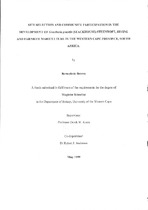Site selection and community participation in the development of Gracilaria Gracilts (stackhouse) steentoft, irvine and farnham mariculture in the Western Cape province, South Africa.
Abstract
The seaweed Gracilaria gracilis has been shown in previous studies to have potential for mariculture along the West Coast of South Africa. However, the selection of suitable sites is crucial for the success of a farming enterprise. The variables important in the success or
sustainability of suspended raft culture, and the environmental factors influencing these variables, were identified through a literature review. A suitable site was defined as a site with surface water temperature of between 10 and 17 "C, water depth of between 2 and 10 m below surface, and wave heights of less than 4 m. Data and information about these factors were obtained from sources such as the Sea Fisheries Research Institute, the SADCO database, the CSIR and from volunteers in St Helena Bay. The objectives of this study were to convert
available data into formats that could be used in a Geographical Information System (GIS), and to predict suitable and available sites for suspended cultivation of Gracilaria gracilis in Saldanha Bay, Langebaan Lagoon and St. Helena Bay. Data were converted to digital format
and data layers created. Each data layer represented suitable and unsuitable areas. Areas with existing mariculture, harbours, ship traffic zones and other uses were excluded to determine the real available areas. The Saldanha Bay-Langebaan lagoon system and St Helena Bay, have sites that show potential for suspended cultivation of G. eracilis. The total sizes of the areas selected as suitable are 975.4 ha in Saldanha Bay and 474.8 ha in St. Helena Bay. Some sites predicted as suitable are located in areas known to be subject to conditions not suitable for seaweed mariculture, and led to the conclusion that the accuracy of input data or method of
analysis must be improved.

